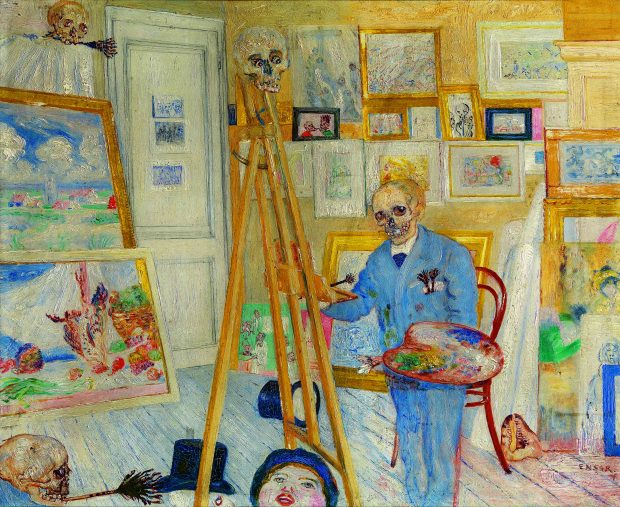On 2 August 1933 one of the more improbable meetings of the 20th century took place when Albert Einstein had lunch with James Ensor. Apparently, Einstein attempted to explain his theory of relativity to Ensor, who doesn’t seem to have understood it. That evening the painter gave a speech, entitled ‘Ensor to Einstein’, ending with a sort of apology. Painters, he exclaimed — ‘alas and alack!’ — were slaves to vision and resistant to ‘positive reason, to calculations, to probabilities’.
However, Intrigue: James Ensor by Luc Tuymans at the Royal Academy is an exhibition that is subject to the principle of relativity. This is not simply a display of work by Ensor, but Ensor as seen from the perspective of Tuymans, the most celebrated of living Belgian painters. The result is curious, not always easy to follow, but distinctly, well, intriguing.
Ensor (1860–1949) was an enigmatic oddball, both as a painter and as a man. His father was an expatriate English alcoholic and his mother came from the Flemish seaside town of Ostend where the family ran a souvenir and curiosity shop. According to Tuymans, Ensor was badly offended when a fellow artist named Léon Spilliaert announced to him that Ostend was not the whole world.
As far as Ensor was concerned, the resort was his entire world. Or at least he spent his life living and working there and the gamey atmosphere of the place — roughly speaking, a blend of Antwerp and Clacton — permeates his work. As a painter, he began as a talented exponent of the gloomy northern European realism of the day.
Early pictures such as ‘The Bourgeois Salon’ (1880) and ‘Afternoon in Ostend’ (1881) depict dark interiors, with heavy impasto and a subdued, stuffy mood. Then, in his mid-twenties, he began making almost wilfully bizarre additions to this middle-class naturalism. His earnest handsome face with a neat Van Dyck beard looks out of a self-portrait of 1883, but it is surmounted by a jaunty hat covered in artificial flowers and trailing a long feather.
Is this a jeu d’esprit, a skilful piece of self-advertisement — which, in fact, still rivets your attention — or is it perhaps a confession that the painter was fond of wearing drag? An essay in the catalogue toys with the possibility that underneath the old woman’s clothes and carnival disguise of the principle figure in a weird and marvellous painting entitled ‘The Astonishment of the Mask Wouse’ (1889) lurked the 29-year-old Ensor himself.
This is not the only moment at which there is a faint suggestion of a fin-de-siècle Belgian Grayson Perry about Ensor. Sometimes, like Perry, he lurches into an idiom close to untrained outsider art, comics or, in the case of ‘The Baths at Ostend’ (1890), an old-fashioned saucy postcard in the style of Donald McGill. This shows a crowded beach scene with numerous cartoony figures in striped bathing costumes and an abundance of naked bottoms protruding from the waves.
Tuymans doesn’t try to explain Ensor’s art, but instead adds an extra layer of complication. His exhibition begins with what appears to be vintage film of Ensor in Ostend from the 1920s, but turns out to be a fake from 2002. He says he wanted to add an element of ‘falsity’ — and that is certainly a suitable note to strike. A great deal of Ensor’s art was about deception and concealment.
‘The Intrigue’ (1890) is the centrepiece of the exhibition. It depicts a group of figures, perhaps revellers at the carnival, with staring eyes and grinning masks. The effect is at once jolly, sinister and unsettling because you don’t quite know how to take it. Is this a satire on middle-class hypocrisy, a joke, a dream? Ensor does not spell it out, and that is part of the power of the picture.
In the catalogue Tuymans hints at a radical thought. He claims that, after Einstein had tried — and failed — to expound relativity to Ensor, he asked him what he painted. Ensor’s reply was ‘nothing’, which is — as Tuymans comments — worth bearing in mind.
Perhaps Ensor’s secret was that he didn’t really have one. Instead he was adding one image to another — collaging them in a way — until they added up to something compelling precisely because it contained contradictions. Many contemporary artists work like this (Gilbert & George, for example), assembling layers of imagery that may not make much rational sense.
‘The Skeleton Painter’ (1896) is based closely on a photograph of the artist in his studio, except that he has transformed himself into a thoughtfully observant death’s head. He stands at his easel smartly dressed in a blue suit, his face a bony skull with large, lustrous eyes.
There is a distinct touch of G&G about Ensor here. It’s not just the suit he’s wearing, it’s also the way you can’t tell if he’s putting you on or not. But then quite a lot of art is like that — as perhaps Ensor was trying to explain to Einstein over lunch (unless, of course, Tuymans made that answer up).






Comments